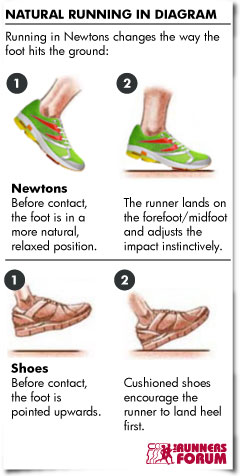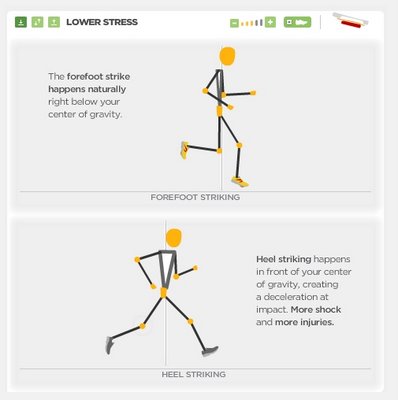Danny Abshire is the author of “Natural Running” (VeloPress, 2010) and the co-founder of Newton Running, a Boulder, Colorado-based company that makes shoes that promote an efficient midfoot/forefoot running gait. He has been making advanced footwear solutions for runners and triathletes for more than 20 years. The following article by Danny will help you safely make the switch to a more natural running style. Just take it slowly. Think of it as ongoing process with incremental increases in weekly mileage and training.
 Whatever your body type, fitness level or experience, the two biggest changes you can make to improve your running performance and reduce the likelihood of overuse injury are:
Whatever your body type, fitness level or experience, the two biggest changes you can make to improve your running performance and reduce the likelihood of overuse injury are:
1. Wear shoes with a nearly level profile
2. Learn how to run naturally
How an Elevated Heel Affects Running Form
For the past 30 years, running shoes have been designed with thickly cushioned, built-up heels. This type of shoe forces the body to balance itself in an unnatural, backward-leaning position. Your toes are pointing downward, your weight is shifted rearward, and your back is slightly arched. Basically, your body struggles to maintain balance while compensating for the lifted heel.
If you’ve been running this way for years — and most people have — it’s likely the muscles and other soft tissue in your feet, lower legs (the Achilles tendons in particular) and core need to adapt to the proper body position that comes with running in flat shoes.
The Achilles tendon acts like a large rubber band that stretches and recoils with every stride. If you’ve been wearing shoes with an elevated heel — including your everyday work and casual shoes — your Achilles tendon has a shorter range of motion. When you begin running in a level shoe like a Newton Running shoe, the Achilles tendon needs to stretch to accommodate for the 10-15 mm distance that used to be taken up by an elevated heel.
How to Make the Switch
If you abruptly transition from an elevated heel to doing all your mileage in a level shoe, you’re likely to feel some Achilles and calf muscle soreness. Instead, make the transition gradually: run less than a mile at a time a 2 or 3 days per week. Work on your form and build strength in your feet, ankles and lower legs with the following tips:
Work on strength and balance:
▪ Go flat as often as possible! Ease the transition on your Achilles and calf muscles by walking barefoot. Wear flatter shoes even when you’re not running.
▪ Do balancing drills. Stand on one foot with a mostly straight leg, lift the other foot off the ground at a 90 degree angle and close your eyes. If you can maintain balance for 30 seconds with your eyes closed on both sides, you may have enough strength be begin transitioning to level shoes. If you lose balance on either side, make this drill part of your daily regime. (Be sure to work on each foot.)
▪ Do barefoot heel dips on a staircase. While holding on to a wall or railing, balance yourself with your metatarsal heads on the edge of the stair even with the ball of your foot. Slowly dip your heel below the plane of the stair, feeling the stretch in your Achilles and calf muscles and then slowly raise back up.
Increase the flexibility and range of motion in your feet and lower legs:
▪ Do common wall stretches. Lean into a wall with your hands while flexing the lower calf with a flat foot. Do this with both a straight and bent knee and repeat a couple times per day after the muscles are sufficiently warm.
▪ Increase the flexibility of your plantar fascia. While sitting in a chair, cross your leg over your knee and firmly push your fingers or a thumb into the center of the sole of your foot. Maintain that pressure and point your toes up and down to stretch the plantar fascia.

Focus on form:
▪ After a run, use form drills to further develop specific aspects of proper running form. Skipping, bounding, high knees and butt kicks are easy and don’t take a lot of time.
▪ Watch yourself run. Have a friend video your stride in traditional shoes, level shoes and while running barefoot on grass. Notice how your body moves differently in each scenario.
Do your feet land under your center of mass? Are you running with a quick cadence and relatively short strides? Are you running with upright but slightly forward-leaning posture? Are you carrying your arms close to your body at about a 90-degree angle? Adopt this form in your new shoes.
Take it easy!
▪ Your inner marathoner might be craving the challenge and rejuvenation that a long run always brings, but refrain from going on long runs until you’ve gone through a gradual progression. Increase your weekly mileage by no more than 10 percent per week and make sure you’re diligent about self-analyzing your form and your progression.

Newtons need to come with a warning label on the shoe. I was a college track runner & then a triathlete in my 20s. I am now 55. I have run competitively only sporadically since I turned 30. Over those years, when I did run with competitive runners, many have commented that I am a mid-foot runner, esp when we did track workouts. I live on CA, work at home & wlak barefoot often. I ran on low-heel Nikes for a few yrs (Kikuni I think they were called) & loved them. I bought a pair of Newtons. I used them on a treadmill over the rainy winter … total maybe 30 miles in 6 runs, once/wk. OK. Then, rain stopped, over a period of 2 weeks, I ran 3 -4 miles in them 4 – 5x outdoors on slightly hilly courses. Better than OK. I definitely ran faster than I expected. A few wks later, on vacation on Maui, I ran 4 straight days on them on a flat course: 3 miles Day 1, 4 miles Day 2, 5 miles Day 3, (supposedly) 6 miles Day 4. I say supposedly, because after 4 miles on Day 4, my Achilles started hurting. I slowed down but I was 2 miles from home, so I kept jogging. At 5 miles, my Achilles was shredding with every step. I had to stop & limp home for a mile. I could barely walk for a few days (luckily, on Maui, swimming a half-mile in the ocean is a great time). It took a month to recover.
Newtons need to come with a warning label on the shoe. Since I don’t bother racing anymore, I’m not sure what I will even do with them. I’ll probably just use them 1x/wk on a treadmill over the winters.